Warner Bros. (2006-2007), Warner Home Video (November 20, 2007), 2 discs, 292 mins plus supplements, 1.33:1 original full frame ratio, Dolby Digital 2.0 Dolby Surround Stereo, Not Rated, Retail: $19.98
Storyboard:
The Dark Knight builds a Bat-Family as he moves from loner status to father figure, unknowingly preparing himself for joining a new league of heroes.

The Sweatbox Review:
Not everyone hated The Batman when it debuted in 2004. Little kids, for example, who had never seen an episode of 1992’s Batman: The Animated Series, remained blissfully ignorant of just how much better that earlier show had been. This new show was certainly well-animated, in fact more consistently so than B:TAS, but the storylines were simplistic and the designs of the characters shied away from being iconic in favor of being “kewl” or edgy. Certainly, those who had enjoyed the depth and style of B:TAS back in its day found the newer version decidedly lacking. The second season of The Batman tried to bring Batman closer to his roots by introducing Commissioner Gordon to the show, but the stories still failed to click with many viewers. Still, the show did well enough to bring on a third season, which brought Batgirl to the show. Uh, oh. The persona of Batgirl in the show, not to mention her costume design, didn’t ring true to what fans expected, and it just made everyone wonder even harder at where the heck Robin was. (Of course, the character was tied up with the Teen Titans on their own show.) And this brings us to Season Four, also known as the season where they started to get things right.
I don’t just say that Season Four got things “right” because they altered Batman’s jaw line in a subtle re-design. While the pointy chin he wore in previous seasons did look weird to me, I could live with it. (Though I do prefer the more classic look he sports in this season.) No, Season Four gave us back a Batman that most of us recognized in spirit as well as appearance, one who is both competent and works with his partners. Robin got introduced, the stories became a little more cerebral (though still action-packed), and the episodes were generally more satisfying than what had come before. The Riddler still looked unrecognizable, but at least The Joker stayed away from wearing straightjackets. And, by season’s end at least, we FINALLY saw villains get some motivation, something the producers apparently felt was too complex for the kiddie show that they had envisioned when it was created. Watching Season Four, I at first had the feeling that while storylines were going a little darker, the writing was still failing to mature fully. There are some nice gimmicks in this season, but I still had the sense that things played out pretty… literal. However, some of the later episodes this season demonstrate that the writers are capable of making interesting villains for our heroes to encounter. And that makes for much better stories.
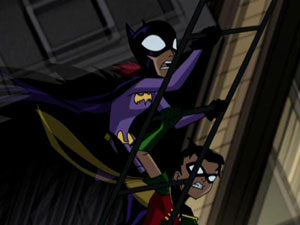
Disc One
The “literal storytelling” problem is quite clear in A Matter Of Family, which introduces Robin to the show. I’m going to drive the producers (and fans) of The Batman nuts and continue to provide unfair comparisons to Batman: The Animated Series… See, on the previous series, the writers recognized that the tale of Robin’s origin was already relatively well known, and had been seen on screen before (in the film Batman Forever). So, they took a non-linear approach to the story, presenting it in flashback while exploring the Dick Grayson character in the present day. Of course, this worked for them since they had already had Robin in their show, and he was now fairly grown up. But the point is, they did something different than just regurgitating Robin’s genesis from orphan to sidekick. I shouldn’t dog on The Batman so much, though; in actuality, this is a pretty good episode. It’s just told in such an ordinary manner (though with stylish animation) that it fails to elevate itself above what one would expect. It did gain points for using B:TAS’s “Batman,” Kevin Conroy, as Dick Grayson’s father, which in this version is the manager of the circus being muscled by gangster Tony Zucco. Plus, Zucco is played by Mark Hamill, who memorably did The Joker on B:TAS. I also give the show credit for making us care more about the Grayson parents before they are killed (compared to watching Robin’s Reckoning on B:TAS), as A Matter Of Family allows us to get to know them better before they are sacrificed. When Robin does appear (almost too quickly), it was good to see him in basically the same costume he used in B:TAS, which itself was based on the comics of the time. (Ironically, only relatively recently the comics have started having their Robin character appear in a red and black costume that was used by Robin in BTAS’s final incarnation, The New Batman Adventures.)

Team Penguin is notable for having Robin and Batgirl meet for the first time. The initially antagonistic relationship, fuelled by rivalry and jealousy, is used to great comic effect. It also serves an important role in having Batman bring Batgirl more fully into his confidence, creating a crimefighting trio that endures for the rest of the series. Once this happens, the relationship between Robin and Batgirl is much more relaxed, and brings just as many smiles as we see two youngsters compete with each other like a son and daughter playfully vying for their father’s approval (or co-conspiring to disobey him). The main plot of this story also provides some genuine laughs, with The Penguin attempting to form a criminal gang using Rag Doll, Killer Croc, and Firefly. A rather pathetic would-be villain named Killer Moth (no relation to the one from the comics or the Teen Titans cartoon) crashes the party, but a chemical accident soon has everyone looking at him in a new light.

Clayfaces sets right something that the first season screwed up (from a fanboy perspective). The Batman’s Clayface to this point had been his childhood friend, police detective Ethan Bennett. While it made for a surprising turn of events at the end of Season One, it was not all that welcomed by long-time fans. In this episode, Clayface gets back to his comic book origins, in fact way back to 1940. In a story from that year, washed-up horror actor Basil Karlo got his revenge on those who he felt had wronged him, by donning an old movie disguise and going on a killing rampage. In this animated version, frustrated out-of-work actor Basil Karlo purposely exposes himself to the Clayface mutagen in order to gain fame for himself. A battle of Clayfaces ensues, with Ethan finally appearing to win some redemption. Nicely done.
The Everywhere Man is a more standard episode, but a good one nonetheless. Brandon “Superman” Routh gives voice to the villain, a man who can replicate copies of himself. While the episode does well to give The Batman a chance to do some real detective work, it will hardly stand up as a classic. The Breakout brings The Black Mask to the show, in an episode that focuses on the evolving partnership of Batgirl and Robin. We can definitely see at this point that they are being played as somewhat realistic kids, in that they have trouble taking things too seriously, and are trying to have fun as they fight crime. Okay, real kids don’t fight crime, but if they did, they’d sound like these two. The interplay between Batgirl and Robin shaped up to be one of the most enjoyable aspects of Season Four. And I didn’t hate Batgirl anymore! Strange New World presents another good gimmick plot, this time being a tale of Batman versus zombies while battling the mind games of Hugo Strange. As the episode progresses, you realize that there is more going on than what is on the surface, and it manages to go past the zombie motif to make for a strong effort.
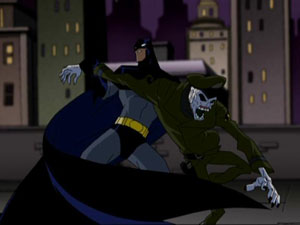
Artifacts is the best gimmick yet, zooming over a thousand years into the future to present the story of a team of archaeologists excavating the Batcave in order to find a way to defeat a newly-awakened Mister Freeze. Instead of tying this story to the present day, though, we get a glimpse at a nearer future, where Robin is now Nightwing, and Barbara Gordon in now Oracle. And Batman looks like a cross between the Frank Miller and Bruce Timm versions. Yes, it’s a pretty cool episode, but I still had the feeling that a stronger writer would have made more of it.

Disc Two
Seconds sees Batman and the kids take on a rather ordinary-looking man with an extraordinary ability. Dave Foley plays Francis, a man who once made a mistake that cost him a lengthy prison term. While in prison, he developed a very unusual talent, which makes him almost impossible to defeat. Francis is actually played as being somewhat sympathetic, making this one of the better-rounded scripts for the season. There is also some good humor in this one, and more of the developing and fun Robin-Batgirl dynamic. The next episode shows that the last was no fluke, as it also gets a strong script with a sympathetic and interesting villain. Riddler’s Revenge brings back the greasy-looking version of the Riddler that the producers came up with. But this time, they give him a backstory and actual motivation, something that many of this show’s villains have lacked in the past.
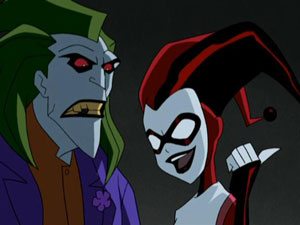
With a script by Paul Dini, things also looked good for the next episode, which brought Dini’s Harley Quinn character into The Batman. While Two Of A Kind falls short of brilliance (I liked Dini’s comic book story Mad Love better), it is plenty fun and succeeds at introducing Harley appropriately while putting a new spin on her character. Here, she’s a spinny pop psychologist with a talk show and questionable credentials. Harley gets her show cancelled, only to find herself approached by her number one fan, one Mr. J! The next episode is notable for including every Batman adversary ever seen on the show, as a new vigilante in town collects supervillains in Rumors. Highlights include Penguin breaking up Catwoman’s heist just to humorously surrender to Batman, and an all-out action finale of the Bat-family taking on all the villains at once. Also wrapped into this plot is the mystery behind the vigilante’s identity, though it’s not hard to see coming.
The two-part finale, which promised even cooler things to come, kicks off withThe Joining – Part One. The Batman is approached by detective John Jones, recently transferred from Denver (nice “comic book origins” touch!), to help investigate mysterious goings-on at Wayne Industries. Of course, Batman finds out that Jones is the Martian Manhunter, J’Onn J’onzz, who asks Batman’s help to foil an alien invasion. Wayne Industries head man Lucius Fox is finally introduced as well. The Joining – Part Two sees the resolution of the invasion threat, which itself is handled in an exciting fashion. The real story, though, is how Batman must come to trust in the abilities of his young partners, and not to try to do so much on his own. But the thing that would really have fans buzzing is the episode’s epilogue, where J’Onn issues Batman an invitation to join a certain group he’s been planning. Oh, yeah… Season Five promised to be pretty cool.
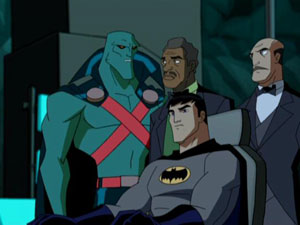
Is This Thing Loaded?
Disc Two opens with a preview of the much-anticipated Justice league: The New Frontier, before offering us the real extras. The Special Features menu brings us The Batman: Season Four Unmasked (9:20), which I was afraid would be one of those terrible, worthless clip things Warner has offered on similar sets. Fortunately, the producers were actually proud of this season, and seem quite happy to talk about it. The featurette sees such creators as Alan Burnett and Jeff Matsuda talking about making every episode this season count, and of course they discuss adding Robin and Harley Quinn to the show. Listening to these guys, it is clear they were on a mission to open up the show and to broaden Batman’s world, while offering quality episodes that fans would actually look forward to seeing.

There are also trailers for Lego Batman: The Video Game and Scooby & Shaggy Get A Clue Volume One.

Case Study:
These sets are getting cheaper. It’s a standard keepcase with a tray to hold one other disc like before, but now we don’t even get an episode listing on an insert. And someone should inform the art department that they revamped Batman’s design— no more pointy chin, guys.
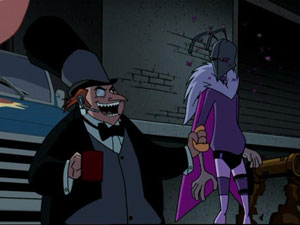
Ink And Paint:
The video is near perfection. The newness of the show is apparent in this bright, sharp 4:3 ratio transfer. I had to be really picky to find a bare amount of occasional shimmer during pans. Otherwise, no artifacting can be seen, and there are of course no physical artifacts owing to the digital production of today’s cartoons.
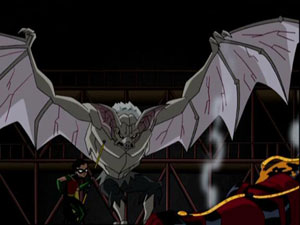
Scratch Tracks:
There is some decent “oomph” in the soundtrack, but it fails to reach the heights of the best stereo surround tracks. The “swirling bats” used in scene transitions provide some of the best use of sound effects on the show, but the action taking place in individual scenes often doesn’t see the soundtrack take full advantage of what is offered. It’s good for a Saturday morning cartoon, but nothing too special. No other languages are offered, and only English subtitles for the hearing impaired.

Final Cut:
Something finally clicked this season for The Batman. The mediocre (some say awful) first season failed to inspire any hope this show would last, much less turn into a good one; but the producers finally gave in and let this show grow up and become more sophisticated. I know they had been aiming for a younger audience initially, but they needn’t have dumbed it down so horribly in the first season, nor have tried so hard to make their version “different.” The addition of Robin actually made Batgirl a more enjoyable part of the show, with their relationship bringing a much-needed sense of fun to the series. The show hit its stride at this point, nicely balancing the new design style with good stories, allowing this show to emerge better from the long shadow of its predecessor.
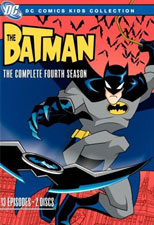 | ||
 |









